Related Research Articles

Blood on the Tracks is the fifteenth studio album by American singer-songwriter Bob Dylan, released on January 20, 1975, by Columbia Records. The album marked Dylan's return to Columbia after a two-album stint with Asylum Records. Dylan began recording the album at an A & R studio in New York City in September 1974. In December, shortly before Columbia was due to release the album, Dylan abruptly re-recorded much of the material in Sound 80 studio in Minneapolis. The final album contains five tracks recorded in New York and five from Minneapolis. The album’s songs have been linked to tensions in Dylan's personal life, including his estrangement from his then-wife Sara. One of their children, Jakob Dylan, has described the songs as "my parents talking." In interviews, Dylan has denied that the songs on the album are autobiographical.

Highway 61 Revisited is the sixth studio album by American singer-songwriter Bob Dylan, released on August 30, 1965, by Columbia Records. Dylan continued the musical approach of his previous album Bringing It All Back Home (1965), using rock musicians as his backing band on every track of the album in a further departure from his primarily acoustic folk sound, except for the closing track, the 11-minute ballad "Desolation Row". Critics have focused on the innovative way Dylan combined driving, blues-based music with the subtlety of poetry to create songs that captured the political and cultural chaos of contemporary America. Author Michael Gray has argued that, in an important sense, the 1960s "started" with this album.

Blonde on Blonde is the seventh studio album by American singer-songwriter Bob Dylan, released as a double album on June 20, 1966, by Columbia Records. Recording sessions began in New York in October 1965 with numerous backing musicians, including members of Dylan's live backing band, the Hawks. Though sessions continued until January 1966, they yielded only one track that made it onto the final album—"One of Us Must Know ". At producer Bob Johnston's suggestion, Dylan, keyboardist Al Kooper, and guitarist Robbie Robertson moved to the CBS studios in Nashville, Tennessee. These sessions, augmented by some of Nashville's top session musicians, were more fruitful, and in February and March all the remaining songs for the album were recorded.
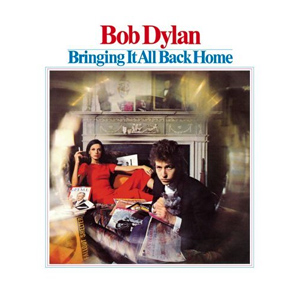
Bringing It All Back Home is the fifth studio album by American singer-songwriter Bob Dylan, released in March 1965 by Columbia Records. In a major transition from his earlier sound, it was Dylan's first album to incorporate electric instrumentation, which caused controversy and divided many in the contemporary folk scene.
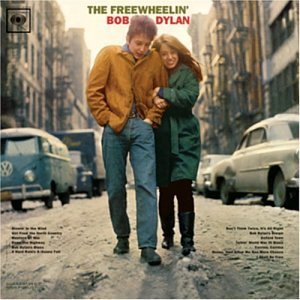
The Freewheelin' Bob Dylan is the second studio album by American singer-songwriter Bob Dylan, released on May 27, 1963 by Columbia Records. Whereas his self-titled debut album Bob Dylan had contained only two original songs, this album represented the beginning of Dylan's writing contemporary lyrics to traditional melodies. Eleven of the thirteen songs on the album are Dylan's original compositions. It opens with "Blowin' in the Wind", which became an anthem of the 1960s, and an international hit for folk trio Peter, Paul and Mary soon after the release of the album. The album featured several other songs which came to be regarded as among Dylan's best compositions and classics of the 1960s folk scene: "Girl from the North Country", "Masters of War", "A Hard Rain's a-Gonna Fall" and "Don't Think Twice, It's All Right".
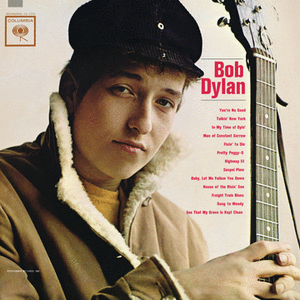
Bob Dylan is the debut studio album by American singer-songwriter Bob Dylan, released on March 19, 1962 by Columbia Records. The album was produced by Columbia talent scout John H. Hammond, who had earlier signed Dylan to the label, a controversial decision at the time. The album primarily features folk standards but also includes two original compositions, "Talkin' New York" and "Song to Woody". The latter was an ode to Woody Guthrie, a significant influence in Dylan's early career.
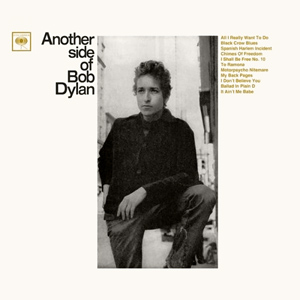
Another Side of Bob Dylan is the fourth studio album by American singer and songwriter Bob Dylan, released on August 8, 1964, by Columbia Records.

The Times They Are a-Changin' is the third studio album by American singer-songwriter Bob Dylan. It was released on February 10, 1964 through Columbia Records. Whereas his previous albums, Bob Dylan and The Freewheelin' Bob Dylan, combined original material and cover songs, this was the first to feature only original compositions. The album consists mostly of stark, sparsely arranged ballads concerning issues such as racism, poverty, and social change. The title track is one of Dylan's most famous; many feel that it captures the spirit of social and political upheaval that characterized the 1960s.
"4th Time Around" is a song by American singer-songwriter Bob Dylan, which was released as the 12th track on his seventh studio album Blonde on Blonde on June 20, 1966. The song was written by Dylan and produced by Bob Johnston. Commentators often interpret it as a parody of the Beatles' 1965 song "Norwegian Wood ". John Lennon composed "Norwegian Wood" after being influenced by the introspective lyrics of Dylan. Lennon later reflected on his feelings of paranoia when Dylan first played him "4th Time Around".

Planet Waves is the fourteenth studio album by American singer-songwriter Bob Dylan, released on January 17, 1974, by Asylum Records in the United States and Island Records in the United Kingdom.

Empire Burlesque is the twenty-third studio album by American singer-songwriter Bob Dylan, released on June 10, 1985 on Columbia Records. Self-produced, the album peaked at No. 33 in the U.S. and No. 11 in the UK.
"Absolutely Sweet Marie" is a song by American singer-songwriter Bob Dylan, which was released on the third side of the double album and Dylan's seventh studio album, Blonde on Blonde (1966). The song was written by Dylan and produced by Bob Johnston. It was recorded at around 1:00 am on March 8, 1966, at Columbia Studio A, Nashville. Some commentators have interpreted the song as being about sexual frustration.

"Rainy Day Women #12 & 35" is a song written and recorded by American singer-songwriter Bob Dylan. Columbia Records first released an edited version as a single in March 1966, which reached numbers two and seven in the US and UK charts respectively. A longer version appears as the opening track of Dylan's seventh studio album, Blonde on Blonde (1966), and has been included on several compilation albums.
"To Ramona" is a song by American singer-songwriter Bob Dylan, first released on his fourth studio album, Another Side of Bob Dylan (1964). The song was written by Dylan, and produced by Tom Wilson. The lyrics were started at the May Fair Hotel in London in May 1964, and finished during a week-long stay in the Greek village of Vernilya later that month. Dylan recorded all the tracks for the album, including the song, in a single three-hour session on June 9, 1964, at Studio A, Columbia Recording Studios, New York. Its narrator advises Ramona, who is preparing to return to "the South", not to follow the advice of others. Critics have suggested several different people as inspirations for the song, including Joan Baez, Suze Rotolo, and Sara Lownds.

Bach: The Goldberg Variations is the debut album of Canadian classical pianist Glenn Gould. An interpretation of Johann Sebastian Bach's Goldberg Variations, the 1956 record launched Gould's career as a renowned international pianist, and became one of the most well-known piano recordings. Sales were "astonishing" for a classical album: it was reported to have sold 40,000 copies by 1960, and had sold more than 100,000 by the time of Gould's death in 1982. In 1981, a year before his death, Gould made a new recording of the Goldberg Variations, sales of which exceeded two million by the year 2000.

"Watching the River Flow" is a blues rock song by American singer Bob Dylan. Produced by Leon Russell, it was written and recorded during a session in March 1971 at the Blue Rock Studio in New York City. The collaboration with Russell formed in part through Dylan's desire for a new sound—after a period of immersion in country rock music—and for a change from his previous producer.
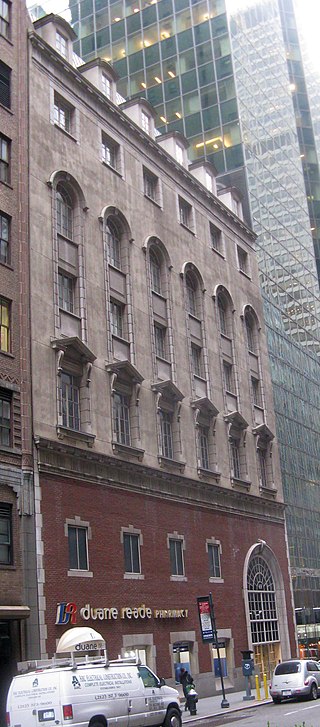
The CBS Studio Building is a seven-story office building at 49 East 52nd Street in Midtown Manhattan, New York City. It has had various uses at different times, including serving as a Vanderbilt family guest house, the first graduate school of the Juilliard School, CBS Radio studios, and Columbia Records studio.

The Bootleg Series Vol. 9: The Witmark Demos: 1962–1964 is a compilation album by American singer-songwriter Bob Dylan, containing demo recordings he made for his first two publishing companies, Leeds Music and M. Witmark & Sons, from 1962 to 1964. The seventh installment of the ongoing Bob Dylan Bootleg Series, it was released on October 19, 2010 on Legacy Records.
"Santa-Fe" is a song that was recorded by Bob Dylan and the Band in the summer or fall of 1967 in West Saugerties, New York. It was recorded during the sessions that would in 1975 be released on The Basement Tapes but was not included on that album. These sessions took place in three phases throughout the year, at a trio of houses, and "Santa-Fe" was likely put on tape in the second of these, at a home of some of the Band members, known as Big Pink. The composition, which has been characterized as a "nonsense" song, was copyrighted in 1973 with lyrics that differ noticeably from those on the recording itself.
A & R Recording Inc. was a major American independent studio recording company founded in 1958 by Jack Arnold and Phil Ramone.
References
- ↑ North, James (Jun 15, 2006). New York Philharmonic: The Authorized Recordings, 1917-2005. Lanham, MD: Scarecrow Press. p. xx. ISBN 9780810862395 . Retrieved December 21, 2014.
- 1 2 3 4 5 6 Simons, David (2004). Studio Stories - How the Great New York Records Were Made . San Francisco: Backbeat Books. ISBN 9780879308179.
- 1 2 3 "Great Sound vs. Bottom Line". Billboard. 1980-11-01.
- ↑ "Armenian Evangelical Church (Congregational) - 152 East 34th", NYC Chapter of the American Guild of Organists
- ↑ "Adams-Parkhurst Memorial Presbyterian Church: 207 East 30th Street at Third Avenue", NYC Chapter of the American Guild of Organists
- ↑ "In Session At The Columbia Records 30th Street Studio". Morrison Hotel Gallery.
- ↑ "Columbia Builds Waxing Studios". Billboard. New York. 1948-12-18. Retrieved 2019-04-04.
Columbia Records has built a new recording studio here which will replace its Liederkrantz Hall wax stages. The diskery has quietly constructed the new studio thru the ban months.
- 1 2 Marks, John, "The Fifth Element #7 Bookmark and Share", Stereophile , March 2002. Cf. pp.1-2, especially p.2
- ↑ Vincent J. Liebler (March 1954). "A Record is Born!". The Columbia Record. Vol. 1, no. 6.
The studio is not only completely soundproof, but heating engineers have also made it completely weatherproof. The studio is approximately 97 feet long, 55 feet wide, and 50 feet from floor to ceiling.
- ↑ Reeves, James, "CBS STUDIO C, a.k.a. 'The Church'", Reeves Audio website.
- ↑ Heylin, Clinton, Bob Dylan: The Recording Sessions, 1960-1994, Macmillan, 1997. Cf. p.33-34 for record producer Tom Wilson's use of the 30th Street Studios for some of Dylan's work, and other references in the book.
- ↑ "Profile: The Wilshire", City Realty
- ↑ "The Wilshire", NY Bits
- Simons, David (2004). Studio Stories - How the Great New York Records Were Made . San Francisco: Backbeat Books. ISBN 9780879308179. Cf. especially, p. 23-24 with an article on "The Church" and elsewhere in the book.